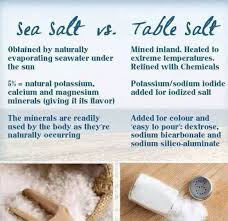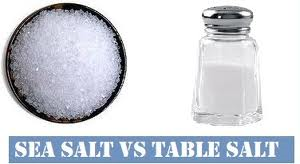The most notable differences between sea salt and table salt are in their taste, texture and processing
Sea salt is produced through evaporation of ocean water or water from saltwater lakes, usually with little processing. Depending on the water source, this leaves behind certain trace minerals and elements. The minerals add flavor and color to sea salt, which also comes in a variety of coarseness levels.
Table salt is typically mined from underground salt deposits. Table salt is more heavily processed to eliminate minerals and usually contains an additive to prevent clumping. Most table salt also has added iodine, an essential nutrient that helps maintain a healthy thyroid.
Sea salt and table salt have the same basic nutritional value, despite the fact that sea salt is often promoted as being healthier. Sea salt and table salt contain comparable amounts of sodium by weight.
Whichever type of salt you enjoy, do so in moderation. The Dietary Guidelines for Americans recommend limiting sodium to less than 2,300 milligrams a day — or 1,500 milligrams if you’re age 51 or older, or if you are black, or if you have high blood pressure, diabetes or chronic kidney disease Sea salt has boomed in popularity in restaurants and supermarket aisles. Many gourmet chefs say they prefer it over table salt for its coarse, crunchy texture and stronger flavor. Manufacturers are using it in potato chips and other snacks because it’s “all natural,” and less processed than table salt. And some health-conscious consumers choose it because it contains minerals like magnesium.
Each of the above-mentioned characteristics may set sea salt apart from table salt, but in one other very important respect there’s usually little difference between the two: sodium content.
How does the amount of sodium in sea salt compare to table salt?
In a survey conducted by the American Heart Association, 61 percent of respondents incorrectly agreed that sea salt is a low-sodium alternative to table salt. Table salt and most sea salts contain about 40 percent sodium by weight. Kosher salt and some sea salts may have larger crystal sizes than table salt, so they may have less sodium by volume (e.g., by teaspoon or tablespoon). A teaspoon of table salt has about 2,300 mg of sodium, but a teaspoon of sea salt or kosher salt may have less sodium because fewer crystals fit into the spoon.
Some varieties of sea salt may claim to have less sodium than table salt. You can check the Nutrition Facts label to compare how a given sea salt compares to table salt, which has about 575 mg sodium per ¼ teaspoon.
“It’s very important for people to be aware that sea salt often has as much sodium as table salt,” said Rachel K. Johnson, Ph.D., R.D., an American Heart Association spokeswoman and the Bickford Professor of Nutrition at the University of Vermont.
“One of the keys to maintaining a heart-healthy diet is to control your sodium intake,” she said. “If you’re consuming more sea salt than you otherwise would because you think it has less sodium, then you may be placing yourself at higher risk of developing high blood pressure, which raises your risk of heart disease.”
Lets review what’s the difference between the way sea salt and table salt are made.
Sea salt is obtained directly through the evaporation of seawater. It is usually not processed, or undergoes minimal processing, and therefore retains trace levels of minerals like magnesium, potassium, calcium and other nutrients.
Table salt, on the other hand, is mined from salt deposits and then processed to give it a fine texture so it’s easier to mix and use in recipes. Processing strips table salt of any minerals it may have contained, and additives are also usually added to prevent clumping or caking.
While these attributes may make sea salt more attractive from a marketing standpoint, Johnson says there are no real health advantages of most sea salts.
“The minute amounts of trace minerals found in sea salt are easily obtained from other healthy foods,” Johnson said. “Sea salt also generally contains less iodine than table salt. Iodine has been added to table salt since the 1920s to prevent the iodine-deficiency disease goiter.”
First off, sea salt is produced by evaporating water from the ocean or saltwater lakes, whereas table salt is usually mined from underground salt deposits. While the exact body of water or deposit can influence the concentration of certain minerals, it doesn’t affect sodium. However, the larger the salt crystals, the fewer that fit in a given volume—be it a pinch, teaspoon, or your entire salt cellar—which could influence how much you end up dishing out.
The next time you find yourself choosing between kosher salt, sea salt and table salt, remember that it’s probably mostly a matter of letting your taste buds decide. But whichever option you choose, keep in mind that both usually contain the same amount of sodium.
As far as health goes, salt has a notoriously bad reputation. But is sea salt any better (or at least less bad) than run-of-the-mill table salt?
The expert: Pamela Peeke, MD, MPH, FACP, nutritionist at Elements Behavioral Health and author of The Hunger Fix
ADVERTISEMENT
The verdict: The answer isn’t as cut-and-dry as most chefs might like, but that’s because the path every salt (even if it’s the same “kind”) takes to reach your shaker varies.
Whether it’s mined from the earth or evaporated from the sea, unrefined salt is always the best option in terms of both flavor and health. However, since boxes nowadays tend to make everything look like a health food, read through the ingredients. If the only thing listed is sodium chloride, you know that the so-called healthy natural salt is just as refined as the table-side variety. (For help decoding those mystifying food labels, look no further.
References:
- Mayo Clinic
- American Heart Association
- FOX News

